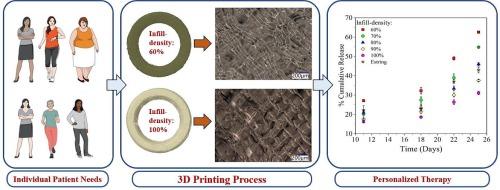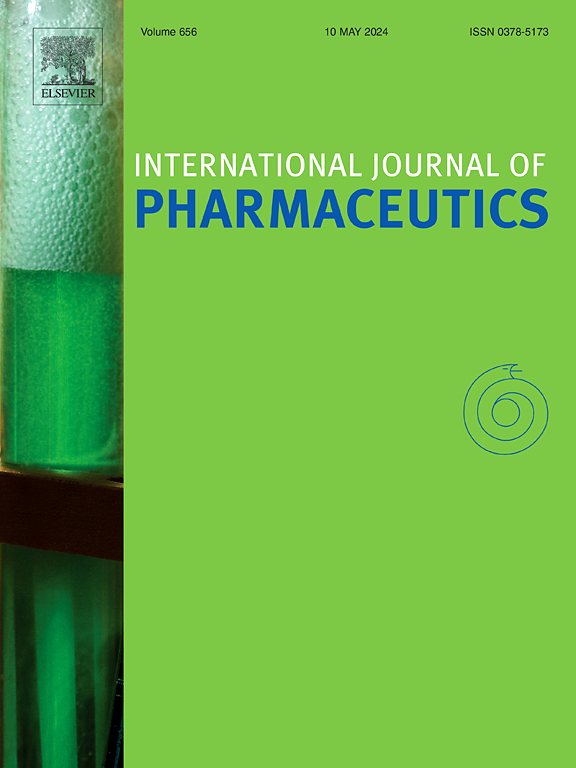基于液滴沉积建模的三维打印技术实现阴道内环的个性化定制
IF 5.3
2区 医学
Q1 PHARMACOLOGY & PHARMACY
引用次数: 0
摘要
阴道内环(IVR)是一种长效药物装置系统,设计用于在阴道内控制药物释放。市售的 IVR 采用 "一刀切 "的开发方法,即所有患者都以相似的剂量和频率接受相同的药物,没有针对特定患者需求进行剂量个体化的空间。为了使剂量个性化具有灵活性,本研究探讨了填充密度对个性化 IVR 关键特性的影响,IVR 是利用液滴沉积建模三维(3D)打印技术制造的。采用油涂层方法将模型药物分散在热塑性聚氨酯颗粒表面。IVR 填充密度范围为 60% 至 100%。通过热分析和光谱分析评估了药物和基质的相容性。对 IVR 的重量、孔隙率、表面形态、机械性能和体外药物释放进行了评估。结果表明,3D 打印的 IVR 具有较高的尺寸精度和均匀性,表明打印过程非常稳健。增加填充密度可提高重量、储存模量、杨氏模量、肖氏硬度和压缩强度,同时降低 IVR 的孔隙率。在 25 天的加速温度条件下进行测试时,所有 IVR 都显示出可控的药物释放模式。值得注意的是,填充密度越大,药物释放的百分比就越低。总之,该研究表明,填充密度是个性化三维打印 IVR 关键特性的一个重要参数,可满足患者的个性化需求。本文章由计算机程序翻译,如有差异,请以英文原文为准。

Personalization of Intravaginal rings by droplet deposition modeling based 3D printing technology
Intravaginal rings (IVRs) are long-acting drug device systems designed for controlled drug release in the vagina. Commercially available IVRs employ a one-size-fits-all development approach, where all patients receive the same drug in similar doses and frequencies, allowing no space for dosage individualization for specific patients’ needs. To allow flexibility for dosage individualization, this study explores the impact of infill-density on critical characteristics of personalized IVRs, manufactured using droplet deposition modeling three-dimensional (3D) printing technology. The model drug was dispersed on the surface of thermoplastic polyurethane pellets using an oil coating method. IVR infill-density ranged from 60 to 100 %. The compatibility of the drug and matrix was assessed using thermal and spectroscopic analyses. The IVRs were evaluated for weight, porosity, surface morphology, mechanical properties, and in vitro drug release. The results demonstrated high dimensional accuracy and uniformity of 3D-printed IVRs, indicating the robustness of the printing process. Increasing infill-density resulted in greater weight, storage modulus, Young’s modulus, Shore hardness, and compression strength, while reducing the porosity of IVRs. All IVRs showed a controlled drug release pattern when tested under accelerated conditions of temperature for 25 days. Notably, greater infill-densities were associated with a decrease in the percentage of drug released. Overall, the study demonstrated that infill-density was an important parameter for personalizing the critical characteristics of the 3D-printed IVRs to fit individual patient needs.
求助全文
通过发布文献求助,成功后即可免费获取论文全文。
去求助
来源期刊
CiteScore
10.70
自引率
8.60%
发文量
951
审稿时长
72 days
期刊介绍:
The International Journal of Pharmaceutics is the third most cited journal in the "Pharmacy & Pharmacology" category out of 366 journals, being the true home for pharmaceutical scientists concerned with the physical, chemical and biological properties of devices and delivery systems for drugs, vaccines and biologicals, including their design, manufacture and evaluation. This includes evaluation of the properties of drugs, excipients such as surfactants and polymers and novel materials. The journal has special sections on pharmaceutical nanotechnology and personalized medicines, and publishes research papers, reviews, commentaries and letters to the editor as well as special issues.

 求助内容:
求助内容: 应助结果提醒方式:
应助结果提醒方式:


